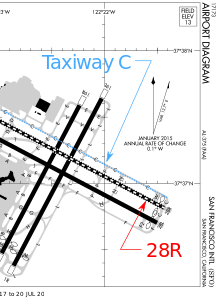Air Canada Flight 759
| Air Canada Flight 759 (AC759) | |
|---|---|
|
Air Canada's C-FKCK aircraft involved in the incident |
|
| Accident summary | |
| Accident type | Near miss |
| place |
San Francisco International Airport , United States |
| date | July 8, 2017 |
| Fatalities | 0 |
| Survivors | 140 |
| Injured | 0 |
| Aircraft | |
| Aircraft type | Airbus A320-211 |
| operator | Air Canada |
| Mark | C-FKCK |
| Departure airport |
Toronto Pearson International Airport , Canada |
| Destination airport |
San Francisco International Airport , United States |
| Passengers | 135 |
| crew | 5 |
| Lists of aviation accidents | |

On July 7, 2017, an Airbus A320-211 operating as Air Canada flight 759 ( flight number AC759 ) as an international scheduled flight between Toronto and San Francisco was involved in a near miss . During the landing approach in San Francisco the aircraft received by the air traffic control the landing clearance for the runway 28R, but the peilte erroneously extending parallel to the runway runway to on which four fully loaded passenger aircraft to their start enable waited. The flight crew initiated a go- around maneuver and was then able to land without further incident. The aircraft waiting on the runway were also able to take off without any problems.
Although such an incident does not necessarily require an investigation, the National Transportation Safety Board (NTSB) decided to investigate because of the potential scope. The subsequent report by the NTSB concluded that the Air Canada aircraft sank to an altitude of 18 m above the ground and was only 4.3 m missing for a collision with one of the other aircraft. According to the report, the flight crew mistook the runway for the taxiway, among other things because of pilot fatigue and unclear lights on the runways. The incident caused a stir internationally, as a collision with a total of five aircraft and over 1000 passengers would have been potentially the worst accident in aviation history.
course
At 11:46 p.m., Air Canada Flight 759 received permission to land on SFO runway 28R. Runway 28L running parallel to it was closed due to construction work and not illuminated . The two pilots mistook runway 28R for runway 28L and therefore kept taxiway C for runway 28R and therefore aimed at taxiway C for landing, as they later stated.
Four planes were already on taxiway C waiting to be allowed to take off, three from United Airlines and one from Philippine Airlines . At 11:55:46 p.m., the AC759 pilot recognized the position lights of the waiting aircraft from a distance of 1.1 km and asked air traffic control via radio whether he was really cleared for landing, which this confirmed. When the plane still 0.48 kilometers from the runway was removed, the pilot of residing on the runway Philippine Airlines flight 115 (PAL115) turned on the landing lights on to draw attention to themselves. At 11:56:01 p.m., a United Airlines Flight 1 (UAL1) pilot interrupted the radio and asked, "Where is this guy going? He's on the runway!" ("Where is this guy going? He's on the taxiway!") The crew of Air Canada 759 started the go-around maneuver immediately afterwards, shortly before they were asked to do so by air traffic control.
During the approach, the Air Canada Airbus sank to an altitude of 18 meters and approached one of the waiting aircraft within 8.8 meters. The Airbus landed safely on the next approach.
There was only one air traffic controller in the tower during the incident, although two controllers are normally always present.
Involved aircraft
| airline | Flight number | Aircraft type | Passengers | Mark | Departure airport | Destination airport |
|---|---|---|---|---|---|---|
| Air Canada | AC 759 | Airbus A320-200 | 140 | C-FKCK | Toronto | San Francisco |
| United Airlines | UAL 1 | Boeing 787-9 | 252 | N29961 | San Francisco | Singapore |
| UAL 863 | Boeing 787-9 | 252 | N13954 | Sydney | ||
| UAL 1118 | Boeing 737-900ER | 177 | N62895 | Cancun | ||
| Philippine Airlines | PAL 115 | Airbus A340-300 | 264 | RP-C3441 | Manila | |
| All in all | 1091 | |||||
Individual evidence
- ↑ DCA17IA148. Retrieved February 3, 2020 .
- ↑ SFO near-miss: Air Canada flight got 'extremely close' to planes on taxiway, pilot on ground alerted tower, averted disaster. In: The Mercury News. July 11, 2017, accessed February 3, 2020 (American English).
- ↑ Eric Levenson, Stella Chan, Carma Hassan and Jon Ostrower CNN: Air Canada plane nearly lands on a crowded taxiway at San Francisco airport. Retrieved February 3, 2020 .
- ↑ 'Close to the greatest aviation disaster in history:' Air Canada pilot almost lands on busy taxiway | The Star. Retrieved February 3, 2020 .
- ↑ '11 seconds to impact ': Expert calculates how close SFO near-miss was to disaster. In: The Mercury News. July 12, 2017, Retrieved February 3, 2020 (American English).
- ↑ NTSB: SFO Runway Lighting Confused Air Canada Pilots | Aviation Week Network. Retrieved February 3, 2020 .
- ↑ DCA17IA148. Retrieved February 3, 2020 .
- ↑ Gerhard Hegmann: Air Canada Flight 759: The plane escaped the mega-catastrophe so narrowly . In: THE WORLD . August 6, 2017 ( welt.de [accessed February 3, 2020]).
- ↑ DCA17IA148. Retrieved February 3, 2020 .
- ↑ NTSB: Air Canada close-call at SFO was even worse than first reported. In: The Mercury News. July 17, 2017, Retrieved February 3, 2020 (American English).
